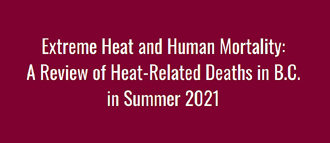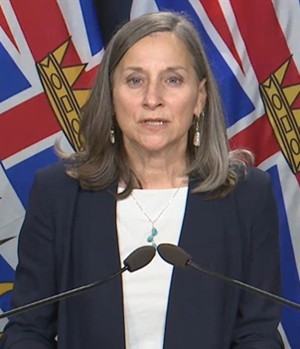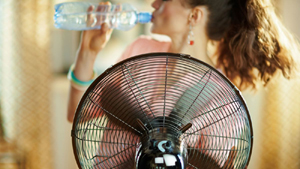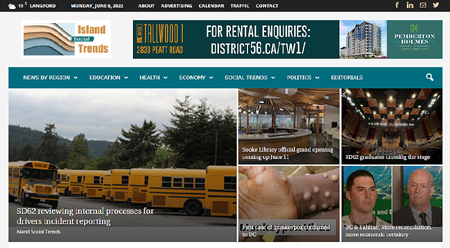
Tuesday June 7, 2022 | VICTORIA, BC [Updated 1:20 pm]
by Mary P Brooke | Island Social Trends
It’s been almost a year since the five-day heat dome in BC in June 2021 ultimately resulted in the heat-related deaths of 619 British Columbians. That finding was determined from investigating more than 800 deaths which occurred betwen June 25 and July 1.
The BC Government — readily faulted from the start for not heeding reliable weather forecasting and not having a suitable and adequate warning system in place — admitted yesterday to needing to ‘do better’ and released a two-part alert system. That system relies on heavily media and local governments. For its part, the provincial government will do more information release and has added extreme heat to the Alert Ready system (which is already used for tsunamis, floods, and Amber Alerts).
Today the BC Coroners Service released its latest death review panel report. Yesterday Health Minister Adrian Dix and also Mike Farnworth, Solicitor General and Public Safety Minister, said they would review the BC Coroners Service recommendations once released.
Coroners report released June 7:
Today at 8 am the report called Human Mortality: A Review of Heat-Related Deaths in BC in Summer 2021 was released online. A livestreamed media session was held at 10 am.
The report is dedicated to the families, friends and communities of those who lost their lives from the impact of the extreme heat event.
“May their memories endure in our actions to prevent similar deaths in the future,” is the statement that opens the 56-page report.
Report findings:
Findings from coroner investigations reviewed by the panel show:
- 98% of deaths occurred indoors;
- there was a lag between the heat alerts issued by Environment and Climate Change Canada and public agencies and the public response;
- heat-related deaths were higher among people on specific chronic disease registries, including schizophrenia, substance-use disorder, epilepsy, chronic obstructive pulmonary disease, depression, asthma, mood and anxiety disorders, and diabetes, compared to the B.C. population;
- more than 60% of decedents had seen a medical professional within the month prior to their death;
- 67% of decedents were 70 or older;
- 56% of decedents lived alone;
- more decedents lived in socially or materially deprived neighbourhoods than the general population;
- most decedents were in homes without adequate cooling systems, such as air conditioners or fans;
- 74% of deaths occurred in Fraser and Vancouver Coastal health authorities;
- Fraser North, Fraser East and Vancouver had the highest rates of deaths by Health Services Delivery Area;
- 911 calls doubled during the peak of the heat dome; and
- paramedics attended 54% of deaths with a median time of 10 minutes and 25 seconds. In 50 instances, paramedics took 30 minutes or longer from the time of the call until they arrived at the scene. In 17 instances, 911 callers were placed on hold for an extended period. In six instances, callers were told that there was no ambulance available at the time of their call.
Three recommendations:
Following extensive review and discussion of the aggregated data, the panel provided advice to the chief coroner that included three recommendations to a number of ministries, agencies and authorities:
1. Implement a co-ordinated provincial heat alert and response system (HARS).
2. Identify and support populations most at risk of dying during extreme heat emergencies.
3. Implement extreme heat prevention and long-term risk mitigation strategies.
The recommendations reflected analysis of the mortality data and/or panel discussions. The chief coroner has forwarded the recommendations to the relevant ministries and organizations.
BC Coroner comment:

“I am very grateful to each of the panel members for their insights, collaboration and commitment to the health and safety of the people of BC”, said Lisa Lapointe, chief coroner.
“We know that weather-related emergencies caused by climate change will continue to challenge us as individuals and as a province. We must learn what we can from the tragic loss of life last summer to support future awareness and focused public health and safety strategies,” she said in today’s news release.
“I am encouraged by the work already underway across ministries and organizations, and believe that the panel͛s recommendations will support improved outcomes for people in B.C., should similar heat events occur in the future,” said Lisa Lapointe.
Media session by Coroners Service:
Today media questions were answered by the BC Coroners Service in a live call at 10 am.
- There was a repeated message about improving the BC Building Code to address cooling (primarily temperature control is about heating in the current BC Building Code). However, that does not directly address owners of rental properties who may need significant financial incentive to refit condos or homes with heat pumps or air conditioning systems.
- There was a repeated message about agencies and communities providing air conditioner units and fans to households in need, or failing that getting people to community cooling centres. Both of those depend on the reliability of heat wave predictions and messaging by government and media. It also requires some form of pre-identification of which households would need that sort of support, and funding to have that amount of hardware on hand. It also implies a high degree of readiness to respond, but makes the distribution of air conditioning units and fans sound easy (it would be rather complicated and time-intensive… people might need to be shown how to install or operate them).
- There was a strong emphasis on community readiness, relying on a wide range of ‘agencies’, including local governments, the ambulance service, hospital emergency rooms, and others. (Yesterday in the session with Health Minister Adrian Dix and Public Safety Minister Mike Farnworth it was said there was ‘no reluctance’ on the part of local governments to do their part to be prepared.)
BC Green comment:
After today’s report was released, the BC Green Party stated in a release, with comments attributable to Adam Olsen, MLA (Saanich North and the islands):
“This report confirmed that vulnerable populations experienced disproportionate deaths. …. “This report makes it clear that we failed to protect our most vulnerable during the heat dome.” … “Telling British Columbians to purchase air conditioners, heat pumps, thermal blinds, fans and digital thermometers is out of touch with the cost of living in this province.”







